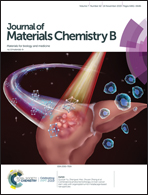Fluorometric and colorimetric analysis of alkaline phosphatase activity based on a nucleotide coordinated copper ion mimicking polyphenol oxidase†
Abstract
In this work, a fluorometric and colorimetric analysis of alkaline phosphatase (ALP) activity was developed based on nanozymes. The nanozymes were composed of nucleotides (ATP, ADP and AMP) coordinated with copper ions. All three kinds of nanozymes (ATP-Cu, ADP-Cu and AMP-Cu) exhibited polyphenol oxidase (PPO)-mimic activity by catalyzing a chromogenic reaction of 2,4-dichlorophenol (2,4-DP) and 4-aminoantipyrine (4-AP). However, there were obvious differences in the PPO-like activity and the fluorescence of the three nanozymes produced from the same concentration of nucleotides (keeping the concentration of Cu2+ unchanged at 5 mM). The catalytic activities of produced ADP-Cu and AMP-Cu were obviously higher than that of ATP-Cu at a certain nucleotide concentration of 3 mM. In addition, when ATP was hydrolyzed into ADP and AMP by ALP, more nanozymes were produced and the catalytic activity of the system was enhanced, which resulted in an obvious increase of the colorimetric signal. The signal intensity was proportional to ALP concentration in the range of 0–30 U L−1, and the detection limit for ALP was 0.3 U L−1 from the colorimetric detection. Moreover, the fluorescence intensity of the produced nanozymes was also proportional to the ALP concentration in the range of 1–30 U L−1 and the detection limit was 0.45 U L−1 from the fluorescence detection. A fluorometric and colorimetric sensing ALP method was thus established. The method showed a high selectivity for ALP activity compared with proteins, amino acids and other interference components. Furthermore, the proposed method was also used to detect ALP activity in human serum samples, which showed great potential for diagnostic and practical purposes.



 Please wait while we load your content...
Please wait while we load your content...